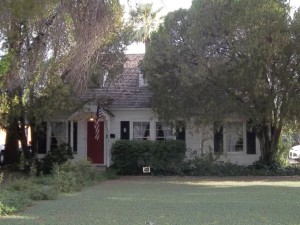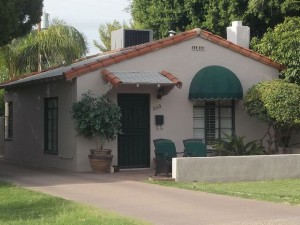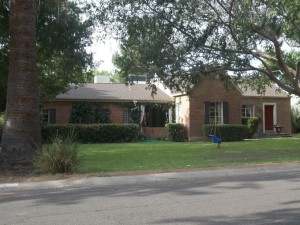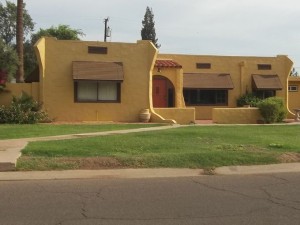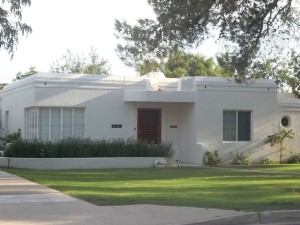The History of Yaple Park Historic District in Phoenix, AZ
Yaple Park Historic District history begins in 1899.
Like many early subdivisions, Yaple Park originated as an irrigated farm on the outskirts of the city.
First Phase of Yaple Park: 1899-1929
Yaple Park, like many early mid-century subdivisions, was carved out of farmland on the outskirts of Phoenix. James M. and Sue Ross Yaple who moved to the Phoenix area in the late 1800’s.
In 1899, they purchased two adjacent farm tracts fronting onto the Grand Canal, in present north Phoenix.
The two parcels were later subdivided as Yaple Park and now comprise the Yaple Park Historic District. Soon after they purchased the land, the couple built a house on 7th Avenue, near the canal. (The Yaple House no longer stands.) At the time, the farm was out in the country, well beyond the Phoenix city limits.
The Yaple’s Were Entrepreneurs
The Yaple’s engaged in several occupations; they bought and sold property and farmed their home tract with water from the Grand Canal, an early pioneer canal in the Salt River Valley. Under irrigation, the farm produced grain crops and citrus fruit.
Agricultural Outbuildings Built
Agricultural outbuildings such as barns, sheds, and greening rooms for citrus, likely were constructed on the land. In 1924, a second house was built for a zanjero who oversaw Yaple’s irrigation system. Built in a Southwest style, the house at 615 W. Minnezona Avenue is the only surviving resource from this first development period.
Second Phase of Yaple Park: 1929-1937
Mr. Yaple died in 1911 but his wife, Sue, maintained the farm for another eighteen years before negotiating a development deal with the Coggins Title Company in 1929. The company had every expectation of success; L.W. Coggins, its president, had considerable experience in Arizona real estate ventures.
Yaple the Mayor
His thirteen years as manager, and then sole owner, of one of the states largest title companies Phoenix Title & Trust; undoubtedly helped him in his successful mayoral bid in 1906. Coggins was re-elected for a second term and under his leadership, Phoenix established a municipal water works, initiated a major sidewalk program, eliminated the city’s debt and balanced its budget.
In 1923, Coggins started the Coggins Title Company with his son, Ralph. The company flourished in the Phoenix building boom of the 1920’s and Yaple Park was expected to be yet another accomplishment to their credit.
Phoenix’s Population Growth
As Phoenix’s population grew in the early 20th century, land owners sought to capitalize on the trend by platting their acreage into residential subdivisions. Yaple Park was platted in 1929 and ten houses were built before 1935, when construction ground to a halt during the Great Depression.
Floyd Medlock Buys Lots
In 1937, however, Phoenix developer Floyd Medlock purchased lots in Yaple Park and began an intensive campaign to attract buyers with the use of newly available Federal Housing Authority (FHA) loans.
Federal financing spurred a building boom that resulted in the construction of 60 new homes in Yaple Park between 1937 and 1941. Although construction stalled during World War II, the remaining lots were developed during the tremendous building boom that occurred after the war and through the 1950’s with the aid of FHA and Veterans Administration (VA) loans
Yaple Park Construction Phases
Yaple Park was developed in three distinct building campaigns that reflect different eras in Phoenix’s residential subdivision in the early-to-mid-20th century.
The initial phase consisted of the Yaple farm and associated resources, such as the ca. 1900 Yaple house, a tenant house, and barns, greening rooms for citrus fruit, sheds and other agricultural features.
The 1924 Tenant House & Turney, Roma, Campbell, and Minnezona Avenues
The Yaple House and agricultural resources are gone but a ca. 1924 tenant house at 615 W. Minnezona Avenue survives from this first era. The second phase is associated with the 1929 Coggins Title Company subdivision of Yaple Park which laid out Turney, Roma, Campbell, and Minnezona avenues.
1929-1935 Development
Ten houses were built between 1929 and 1935 when the Great Depression dampened development throughout the country. The third and most productive phase began in 1937, when Phoenix developer Floyd Medlock began purchasing lots in Yaple Park.
FHA Financing Helps Sales
With newly available Federal Housing Administration (FHA) loans, he helped prospective buyers become homeowners in the tract. Within three years, Medlock oversaw the construction of 59 new homes, most purchased with FHA financing. The remaining lots, also backed by federal financing plans, were developed after World War II in the 1940’s and 1950’s.
The Yaple Park Subdivision Map is Filed
The Coggins Title Company filed the Yaple Park subdivision map with the Maricopa County Recorders office on April 22, 1929. The subdivision covered the Yaple’s two farm tracts which were tucked between 3rd and 7th Avenues, just south of Grand Canal.
It consisted of six long blocks with between 21 and 24 lots, most of which fronted onto the east-west streets: Turney, Roma, Campbell and Minnezona Avenues.
The northernmost street, Minnezona, generally followed the alignment of the Grand Canal which formed the subdivisions northern boundary. The Yaple House and zanjero house remained on their lots near the Grand Canal; the Yaple House fronted onto 7th Avenue and the zanjero house faced Minnezona and the canal.
Promoting the Subdivision
The Coggins hired Gammon and Gammon to promote the subdivision and on August 11, 1929, the advertising firm reported that two homes had been completed and three more were under construction.
The Stock Market Crash
Two months later, the stock market crash and ensuing depression all but halted construction in the development.
Only ten homes were built between 1929 and 1935. Those that were completed adopted popular styles of the day including the Southwest Style, English Cottage, and Transitional Ranch, a harbinger of the many Ranch style variations that would appear in the late 1930’s and through the postwar period.
Third Phase of Yaple Park: 1937-1960
Development in Yaple Park had ground to a standstill before a young developer, Floyd Medlock, began purchasing lots in the subdivision in 1937.
Medlock. the Realtor
Medlock was a cotton broker and developer and in his early twenties, served as the youngest member of the Phoenix Board of Realtors. By the time he started buying lots in Yaple Park he had already successfully developed two other subdivisions.
He followed the trend of buying inexpensive farm land far beyond the city limits and developing it into suburban residential tracts (Arline, Phoenix Gazette 1985: A).
Medlock’s First Venture
His first venture, Medlock Place, was carved out of a 25-acre cotton field and divided it into 46 lots along both sides of Colter Street between Central and 3rd Avenues.
The following year, Medlock purchased 20 acres of land at the northwest corner of Camelback and Central, adjacent to Medlock Place.
South Medlock Place
He called the new subdivision South Medlock Place and dedicated the main streets for commercial development and reserved Pasadena and Medlock streets, for residential construction.
Medlock placed minimum price restrictions on his subdivisions to assure prospective buyers that the neighborhoods would be high-class developments. He worked through the 1920’s and 1930’s to sell lots in his early subdivisions.
Even during the Great Depression, Medlock avidly promoted his remaining 42 lots by advertising Medlock Place (Listed in the National Register June 2006) and South Medlock Place as having a complete network of paved streets, water and disposal systems, electrical and telephone service and dotted with more than 5,000 trees (Arline, Phoenix Gazette 1985: A).
Advertising Campaigns in the Arizona Republic
In 1937, Medlock turned his attention to Yaple Park. On November 7, 1937, he launched an advertising campaign in the Arizona Republic announcing the opening of Yaple Park (See Advertisements for Yaple Park in the Arizona Republic November 7, 1937 in Additional Items).
Of course, subdivision development in Yaple Park had started in 1929, with ten homes built by 1935, but the Depression had brought construction to a standstill and Medlock seized the opportunity to turn things around.
Creating Affordable Housing
The economy may have played a role in Medlock’s promotion of Yaple as well. He offered affordable houses to average Americans.
This theme was reiterated by builder W.M. Rasmussen who placed an ad to accompany Medlock’s. He described Yaple Park as “priced for average Americans to afford these beautiful homes are your answer to better, happier, more economical living.”
(FHA) Financing for $15 a Month Adds to Yaple Park Historic District History
To reach these average Americans, Medlock noted the availability of the new Federal Housing Authority (FHA) financing for the Yaple Park development. Such loans were intended for Medlock’s ideal demographic.
Lots sold at prices ranging between $400 and $550, with $100 down payment and only $15 per month (Arline, Phoenix Gazette 1985: A). The Coggins Title Insurance and Trust Company continued to issue titles for the property (The Arizona Republic, November 7, 1937: 6).
Promoting Yaple Park
Medlock’s initial promotion extolled the virtues of suburban life in Yaple Park such as mountain views, cooler summer temperatures, and irrigation. He acknowledged that the subdivision was about two miles north of Phoenix city limits.
But, that paved streets on either side of the Medlock neighborhood would allow the businessman to live in a pleasant suburb yet be within a few minutes drive of his office.
His opening day ad also noted that the development had rigid building restriction that would insure each home owner absolute protection on his investment. An article in the same issue of the Arizona Republic noted that these restrictions were the evolution of tried and tested covenants and were supported by the Federal Housing Administration.
Frame and Masonry Houses
Both frame and masonry houses were allowed, but frame houses had to be larger in size to maintain equivalent values. The article went on to note that the restrictions in Yaple Park were intended to result in a desirable subdivision appearance and would allow a homeowner to protect his rights without infringing on others (The Arizona Republic, November 7, 1937: 6).
Subdivision Restrictions Assures Quality
Like many early 20th century developers, Medlock generally sold lots to individuals who then hired contractors to build their homes. His subdivision restrictions assured quality control for building size, type, setback, materials, etc. but style was largely left to the individual homeowners.
Period Revivals & Modernistic Homes
The district already featured a number of different Period Revival styles. As a result, the district features a variety of residential styles spanning the mid-1920’s through the 1950’s. Medlock also approved the Modernistic Romley house at 505 Roma Avenue (See Modernistic Home Attracts Attention from the Arizona Republic, April 24, 1938, in Additional Items).
However, variations on the Ranch style prevail as most of the houses were built during the late 1930’s and in the postwar era when the style enjoyed its greatest popularity. Use of Federal Housing Authority loans affected building designs and methods as they encouraged efficient floorplans, ceiling heights, and materials.
Medlock’s Successful Despite the Depressed Economy
Medlock’s venture was highly successful in light of the depressed economy. A total of 56 houses (51%) were built in Yaple Park between 1937 and 1940. The accomplishment was due both to Medlock’s enthusiastic promotion and attention and to the newly available FHA loans that made home ownership possible for working and middle class families.
As advertised, most of the early homeowners in Yaple Park were indeed families of modest means who managed to buy their own homes.
One of the first, J. P. Roe (502 W. Turney Avenue) was a postal carrier in 1934. By 1940, when the subdivision was more than half-way built out, occupants included:
- office managers (L. B. Smith, 304 W. Campbell Avenue; Ray Gilbert, 302 W. Roma Avenue), building contractors (R. T. Moore, 310 W. Campbell Avenue),
- bookkeepers and clerks (Al Gorman, W. 321 Minnezona Avenue; L. A. Roberts, 510 W. Turney Avenue),
- mechanics (W. T. Carpenter, 615 W. Minnezona Avenue; J. M. Romley, 505 W. Roma Avenue),
- and a handful of professionals (D. D. Felshaw, principal Fowler School, 309 W. Minnezona Avenue) (Phoenix city directory, 1940).
World War II
Restrictions on nonessential construction during World War II again stymied the completion of Yaple Park. Although some houses were constructed during the war, the district was finally built out in the postwar period.
Many were built in 1946, right after the war (Phoenix city directory, 1946), although a few vacant lots remained at the end of the 1950’s. From the start of World War II in 1941, through the postwar period ending in 1960, thirty-four homes were constructed in Yaple Park.
Postwar Period
In the immediate postwar period, the neighborhood continued to be largely owner-occupied but with a different range of occupations:
- In 1946, several salesmen (F. A. Yost, 321 W. Minnezona Avenue; I. E. Super, 333 W. Minnezona Avenue) lived in the district.
- An accountant (Thomas Clark Jr., 344 W. Turney Avenue), a lawyer (Nathaniel Rubinkam, 351 W. Roma Avenue),
- and a nursery school operation (Elsie Morely, 625 W. Campbell Avenue), lived in the neighborhood.
- Interestingly, the assistant business manager (E. G. Shaver, 304 W. Campbell Avenue) for Del Webb Construction Co., poised to be one of the largest tract developers in Phoenix.
- The state director of the FHA (R. O. Barrett, 356 W. Roma Avenue) which made many of the homes in the district possible, both owned homes in Yaple Park.
Commercial Development Pressures
By the late 1940’s, Phoenix had grown out to encompass Yaple Park and residents in the quiet suburban tract began to feel commercial development pressures, especially along 7th Avenue.
In 1949, Yaple Park residents requested annexation by the city of Phoenix because they hoped the city would impose restrictions on commercial building in the otherwise residential area.
Yaple Park’s deed restrictions had previously been declared invalid by a court of law. Corwin Mocine, city planning director, was quoted in the Arizona Republic as saying. This is an example of the weakness of deed restrictions in accomplishing the orderly growth of residential areas.
He went on to explain that city regulated zoning was required to control commercial growth (Yaple Park Area Seeks Annexation by Phoenix, The Arizona Republic, January 29, 1949). Despite the loss of 7th Avenue to commercial development, the remainder of Yaple Park remains entirely residential.
Today, Yaple Park is one of the finest historic districts in Phoenix with a prime, central location.
Yaple Park Historic District lies just a little bit north of central Phoenix and follows the original 1929 Yaple Park subdivision plat 1929 in it is bounded by Minnezona Avenue to the north, Turney Avenue to the south, 7th Avenue to the west, and 3rd Avenue to the east. Its northern border, Minnezona, abuts the Grand Canal, an integral part of the regions irrigation system.
